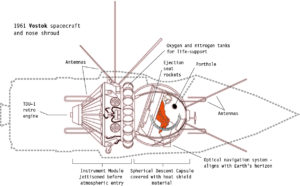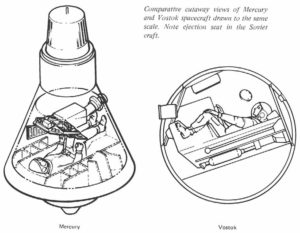Peter Lobner
On 12 April 1961, the Soviet Union launched the Vostok 1 (“East” 1) spacecraft and astronaut Major Yuri Gagarin from a launch site in Kazakhstan on the first ever manned space mission. Gagarin became the first person to fly above the Karman line that marks the beginning of space, at 62 miles (330,000 feet, 100 km) above the Earth. He also became the first person to achieve Earth orbit.
 Yuri Gagarin. Source: Daily Mail
Yuri Gagarin. Source: Daily Mail
Basic orbital parameters for Vostok 1 were: apogee: 203 miles (327 km), perigee: 117 miles (189 km), and orbital period: 89.1 minutes. Gagarin completed one orbit. After re-entry, Gagarin ejected from the Vostok capsule at an altitude of about 4.3 miles (7 km) and parachuted to the ground. The capsule descended under its own parachute and was recovered near Engels, Russia. Gagarin’s total flight time was 1 hour, 48 minutes.
The path of Gagarin’s historic flight, including important flight milestones, is shown on the following map:
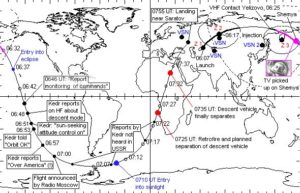 Source: http://space.stackexchange.com/
Source: http://space.stackexchange.com/
The configuration of the Vostok spacecraft is shown in the following diagram. The reentry vehicle is the spherical capsule, which on the left is shown attached to the instrument module.
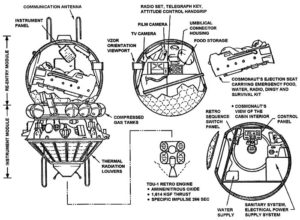 Vostok 1 configuration. Source: Pinterest
Vostok 1 configuration. Source: Pinterest
The complete spacecraft had a mass of 4.73 tons (4,300 kg) and measured 14.4 feet (4.4 meters) in length and 8 feet (2.43 meters) in diameter. The placement of the spacecraft inside the nose shroud of the launch vehicle is shown in the following diagram.
Source: http://www.rocketryforum.com/showthread.php?49802-Dr-Zooch-Vostok-build-thread
Yuri Gagarin’s Vostok I capsule is on display at the RKK Energiya museum, which is on the grounds of the RKK Energiya factory in Korolyov, near Moscow. Gagarin died in a jet training flight on 27 March 1968.
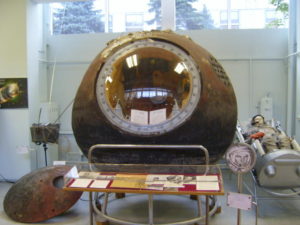 Vostok 1 capsule. Source: SiefkinDR – Own work, CC BY-SA 3.0, https://commons.wikimedia.org/w/index.php?curid=12403404
Vostok 1 capsule. Source: SiefkinDR – Own work, CC BY-SA 3.0, https://commons.wikimedia.org/w/index.php?curid=12403404
The Soviet’s Vostok launch vehicle was unveiled to the public at the June 1967 Paris Air Show. This was a big launch vehicle for the time, with a length of 126 feet (38.4 m) and a diameter of about 35 feet (10.7 m).
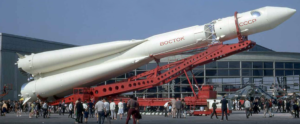 Soviet Vostok launcher mockup at 1976 Paris Air Show. Source: http://www.theaviationhistorian.com
Soviet Vostok launcher mockup at 1976 Paris Air Show. Source: http://www.theaviationhistorian.com
The Vostok launcher, designed by Sergei Korolov, was based on the Soviet R-7 (Semyorka) intercontinental ballistic missile (ICBM). Earlier versions of the R-7 were used to put the first man-made satellite, Sputnik 1, in Earth orbit on 4 October 1957 and to launch the early Luna spacecraft that, in 1959, achieved the milestones of first spacecraft to escape Earth’s gravity and enter a solar orbit (Luna 1) and first spacecraft to impact the Moon (Luna 2).
About one month after Gagarin’s milestone orbital flight, U.S. Project Mercury astronaut Alan Shepard was launched on 5 May 1961 by a Mercury-Redstone booster on a 15-minute suborbital flight. In the Freedom 7 capsule, Shepard reached a maximum altitude of 116.5 miles (187.5 km) and was recovered about 302 miles (487 km) downrange from Cape Canaveral after landing in the Atlantic Ocean. The Freedom 7 capsule is on display in the museum at the John F. Kennedy Presidential Library on Columbia Point in Boston, on loan from the Smithsonian National Air and Space Museum. Alan Shepard died on 21 July 1998.
On 20 February 1962, astronaut John Glenn became the first American to reach Earth orbit. The Mercury-Atlas booster placed the Friendship 7 capsule and Glenn into a low Earth orbit with the following basic parameters: apogee: 154 miles (248 km), perigee: 87 miles (140 km), and orbital period: 88.5 minutes. Glenn completed three orbits in a flight lasting 4 hours and 55 minutes, with recovery in the Atlantic Ocean. The Friendship 7 capsule is on display at the Smithsonian National Air and Space Museum, Washington D.C. John Glenn died on 8 December 2016.
A comparison of the Mercury and Vostok reentry capsules is shown in the following scale diagram.
Source: http://abyss.uoregon.edu/~js/space/lectures/lec08.html
So here we are, 56 years later and some things haven’t changed. Just as in 1961, the U.S. has no means of its own to send astronauts into Earth orbit. The first orbital test of an unmanned SpaceX Dragon 2 spacecraft, launched by a SpaceX Falcon booster, is scheduled for November 2017, with the first crewed mission occurring in 2018. When it occurs, this manned Dragon 2 mission will be the first U.S. manned spacecraft to reach orbit since the last Space Shuttle flight in 2011. Dragon 2 will provide regular service to replace International Space Station (ISS) crews and to perform other orbital missions requiring a crew. In the meantime, the U.S. depends on Russia and their Soyuz spacecraft to deliver and return crews from the ISS. Soyuz is a larger, more modern version of the basic Vostok spacecraft and spherical reentry capsule. You can find out more about the Soyuz spacecraft currently serving the ISS on the National Aeronautics and Space Administration (NASA) website at the following link:
https://www.nasa.gov/audience/forstudents/k-4/stories/nasa-knows/what-is-the-soyuz-spacecraft-k-4
NASA’s manned space program will take even longer to resume manned spaceflight missions. The first launch of NASA’s Space Launch System (SLS) with the new Orion multi-purpose crew vehicle currently is expected to occur in 2018. As currently planned, the Exploration Mission 1 (EM-1) will be an unmanned mission. NASA is considering making EM-1 a manned mission and launching in 2019.
